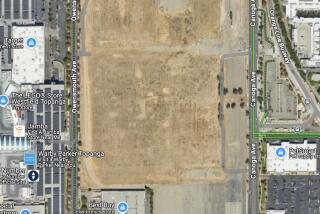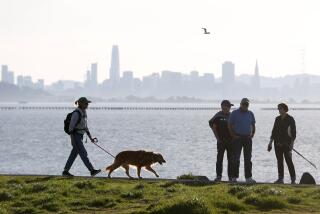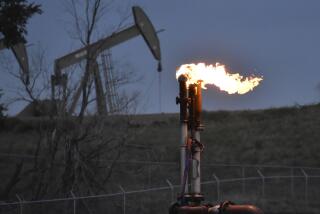Australian scientists find excess greenhouse gas near fracking
Environmental researchers have detected excess greenhouse gas levels near the site of Australia’s biggest coal seam gas field, prompting calls for halting expansion of hydraulic fracturing until scientists can determine whether it might be contributing to climate change.
The reported findings of methane, carbon dioxide and other compounds at more than three times normal background levels have stirred new controversy in eastern Australia over the pros and cons of boosting natural gas output by “fracking,” a process that blasts sand, water and chemicals into deep underground wells.
Researchers from Southern Cross University took mobile air testing equipment to the Tara gas field near Condamine in Queensland to measure the ambient gas content. They found more than three times the level of toxic gases than expected, based on the industry’s claim that leakage from the wellheads is “negligible.”
“The concentrations here are higher than any measured in gas fields anywhere else that I can think of, including in Russia,” Damien Maher, a biochemist who helped conduct the tests, told the Sydney Morning Herald.
The findings, though still pending peer review before publication, could influence the scope and pace of a planned expansion of coal seam gas fracking as envisioned in a white paper issued this week, environmentalists said. Development authorities in New South Wales state are weighing whether to allow energy companies to drill 66 new wells in the western suburbs of Sydney to extract natural gas through fracking.
At sites within a few miles of the Tara field wellheads, methane was measured as high as 6.89 parts per million, compared with a normal background level of about 2 parts per million, the air test results showed.
Some scientists surmise that the excess levels are due to seepage of the gas through displaced soil and aquifers that carry “fugitive” emissions released by fracking a mile or more below ground. Carbon cycle expert Peter Rayner of the University of Melbourne told the Australian Broadcasting Corp. that the elevated gas levels were probably due to “emissions that escape from the intended process of production.”
Health authorities and opponents of the plans to expand fracking have called on the governments of Queensland and New South Wales to determine greenhouse gas levels in the atmosphere in areas slated for new wells before they are drilled, to provide a baseline for comparison with air quality after the underground seams are fractured.
“There are many things we don’t know here, but we do know that the results show widespread elevated levels, and it really highlights the need for baseline studies so we can determine whether this is due to the coal seam gas operations or not,” Isaac Santos, a geochemist who worked with Maher on the study, told journalists Wednesday, when the Southern Cross research results were made public.
Santos told Australian journalists that the findings showed greenhouse gases at levels even higher than in Russia’s massive Siberian gas fields, where environmental protection has been minimal.
Helen Redmond, a physician with the New South Wales chapter of Doctors for the Environment, cited rising complaints of rashes, nausea, headaches and nose bleeds among people living close to the Tara gas fields.
“Hydrocarbon exposure cannot be ruled out as a cause without much more comprehensive investigation,” she told the Sydney newspaper, which also quoted a New South Wales Health Department official as saying the government agency should be included in public hearings on fracking plans.
Queensland Premier Campbell Newman, an avid proponent of expanding coal seam gas extraction, told Australia’s ABC Radio that he would look into the researchers’ findings because he wouldn’t tolerate “any activities in any industry” that damage people’s health or the environment.
Rick Wilkinson, chief operating officer for the Australian Petroleum Production and Exploration Assn., said the findings were premature and biased.
“Incomplete research from Southern Cross University academics this week lacks the basics of scientific rigor,” Wilkinson said in a statement. “The claim that large-scale fugitive gas emissions are a result of coal seam gas production, before they even do their research, seems to indicate a bias against coal seam gas.”
Residents of rural Queensland were initially enthusiastic about the prospects of coal seam fracking bringing jobs and revenue to their state when political leaders began touting the practice about seven years ago. More than 4,500 wells have been drilled in the last three yeas, and work has begun on a 250-mile pipeline from the gas fields to Gladstone Harbor and a massive liquefaction facility there.
Concerns about fracking’s consequences for air and water quality have been rising, though, as farmers complain of a dropping water table and piles of debris left behind by the drilling and extraction operations.
ALSO:
Widely condemned U.S. policy on Cuba unlikely to change soon
War crimes tribunal overturns convictions of 2 Croatian generals
Egypt takes more aggressive, and less neutral, approach to Gaza
More to Read
Sign up for Essential California
The most important California stories and recommendations in your inbox every morning.
You may occasionally receive promotional content from the Los Angeles Times.











